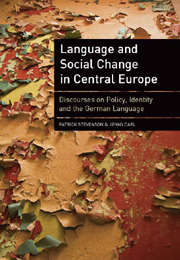Book contents
- Frontmatter
- Contents
- Acknowledgements
- List of Tables
- Transcription Conventions
- Map of Central Europe
- 1 Introduction
- 2 Discourses on Language in Social Life: Theoretical and Methodological Orientations
- 3 Sociolinguistic Histories and the Footprint of German in Eastern Central Europe
- 4 Language Policy Discourses: Interventions and Intersections
- 5 Language (Auto)biographies: Narrating Multilingual Selves
- 6 Language Ideologies: Negotiating Linguistic Identities
- 7 Conclusions
- Appendix A European Institutions and Documents Concerning Language Policy
- Appendix B Preamble to the European Charter for Regional or Minority Languages
- Appendix C Introduction to the 2005 Commission Communication ‘A New Framework Strategy for Multilingualism’
- Appendix D Introduction to the 2008 Commission Communication ‘Multilingualism: an asset for Europe and a shared commitment’
- Appendix E German and Austrian agents and institutions in foreign cultural policy
- Appendix F Extract from ‘Auswärtige Kulturpolitik – Konzeption 2000’
- Appendix G Central focus – ‘Leitbild’ – of the Goethe-Institut
- Appendix H Austria's Auslandskulturkonzept NEU
- Appendix I Plattform Kultur Mitteleuropa – Platform Culture Central Europe
- Appendix J Extract from Austria kulturint – Tätigkeitsbericht 2002
- Appendix K Czech 2001 White Paper on Education
- Appendix L Czech 2004 Education Act
- Appendix M Extract from Czech Follow-up of Action Plan on Language Learning and Linguistic Diversity
- Appendix N Hungarian 1997 Directive Concerning the Education for National and Ethnic Minorities
- Appendix O Extract from 2007 Hungarian National Core Curriculum
- Appendix P Extract from Hungarian Follow-up of Action Plan for Language Learning and Linguistic Diversity
- References
- Index
Appendix N - Hungarian 1997 Directive Concerning the Education for National and Ethnic Minorities
Published online by Cambridge University Press: 05 February 2013
- Frontmatter
- Contents
- Acknowledgements
- List of Tables
- Transcription Conventions
- Map of Central Europe
- 1 Introduction
- 2 Discourses on Language in Social Life: Theoretical and Methodological Orientations
- 3 Sociolinguistic Histories and the Footprint of German in Eastern Central Europe
- 4 Language Policy Discourses: Interventions and Intersections
- 5 Language (Auto)biographies: Narrating Multilingual Selves
- 6 Language Ideologies: Negotiating Linguistic Identities
- 7 Conclusions
- Appendix A European Institutions and Documents Concerning Language Policy
- Appendix B Preamble to the European Charter for Regional or Minority Languages
- Appendix C Introduction to the 2005 Commission Communication ‘A New Framework Strategy for Multilingualism’
- Appendix D Introduction to the 2008 Commission Communication ‘Multilingualism: an asset for Europe and a shared commitment’
- Appendix E German and Austrian agents and institutions in foreign cultural policy
- Appendix F Extract from ‘Auswärtige Kulturpolitik – Konzeption 2000’
- Appendix G Central focus – ‘Leitbild’ – of the Goethe-Institut
- Appendix H Austria's Auslandskulturkonzept NEU
- Appendix I Plattform Kultur Mitteleuropa – Platform Culture Central Europe
- Appendix J Extract from Austria kulturint – Tätigkeitsbericht 2002
- Appendix K Czech 2001 White Paper on Education
- Appendix L Czech 2004 Education Act
- Appendix M Extract from Czech Follow-up of Action Plan on Language Learning and Linguistic Diversity
- Appendix N Hungarian 1997 Directive Concerning the Education for National and Ethnic Minorities
- Appendix O Extract from 2007 Hungarian National Core Curriculum
- Appendix P Extract from Hungarian Follow-up of Action Plan for Language Learning and Linguistic Diversity
- References
- Index
Summary
Beilage Nr. 1 zur Verordnung 32/1997 (5.XI.)
Richtlinien für die Bildung im Kindergarten der nationalen und ethnischen Minderheiten
Einleitung
Die Bildung und Erziehung der nationalen und ethnischen Minderheiten ist Teil des einheitlichen Erziehungs- und Bildungsplans unseres Landes, das seine spezifischen Ziele und Aufgaben mit denen im Landesgrundprogramm der Erziehung im Kindergarten in Einklang mit der Regierungsverordnung 137/1996 (28.VIII.) verwirklicht.
Die Richtlinien der Erziehung der nationalen und ethnischen Minderheiten bestimmen die Grundprinzipien der pädagogischen Arbeit in den Minderheitenkindergärten. Die Richtlinien des Minderheitenkindergartens beinhalten die Ziele und Aufgaben der Erziehung der Minderheiten. Sie verfügen auch über die Prinzipien, nach denen die Arbeit im Kindergarten verläuft, über die Formen und die Charakteristika der Entwicklung der Minderheitenerziehung bis zum Ende des Kindergartenalters.
Ziele und Aufgaben der Bildung im Minderheiten-Kindergarten
Die Bildung im Minderheiten-Kindergarten dient dazu, entsprechend den Altersbedingungen und der individuellen Entwicklung der Kinder in diesem Alter, dass die Kinder die Sprache und die Kultur der Minderheit kennen lernen und sich aneignen, dass die kulturellen Traditionen weitergegeben und entwickelt werden.
Ziel und Aufgabe der Bildung für Minderheiten ist es, dass
für die Kinder eine muttersprachliche Umgebung geschaffen wird,
die für das Minderheitendasein wichtigen, an die Kultur und die Lebensweise der Minderheit anknüpfenden Traditionen und Bräuche entwickelt und gepflegt werden,
die Kinder auf den schulischen Minderheitenunterricht vorbereitet werden,
die Entwicklung der Minderheitenidentität gefördert wird.
- Type
- Chapter
- Information
- Language and Social Change in Central EuropeDiscourses on Policy, Identity and the German Language, pp. 243 - 245Publisher: Edinburgh University PressPrint publication year: 2010

